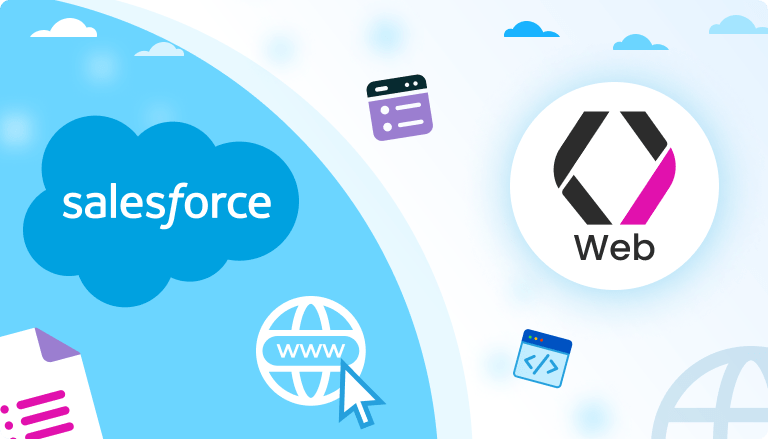
Introduction or Why Do We Need Student Portals?
A student portal is rapidly becoming an essential tool for educational institutions aiming to streamline and modernize student interactions. From enrolling in classes to accessing academic resources, students benefit from having a central online hub that organizes everything in one place. Traditionally, creating these portals required complex coding, but now tools like Salesforce Experience Cloud and Titan offer accessible, modern solutions.
Take the example of a college using a Salesforce no-code tool, to simplify its application process. Previously, the college handled everything manually: students submitted paper applications, administrators entered information by hand, and all communications took place through emails or phone calls. By integrating the no-code portal, students can now view application statuses, create and use Salesforce electronic signature, update personal details, and even pay fees online, all in real-time through Salesforce. This streamlined setup reduces workload, minimizes delays, and improves the overall student experience, showing how no-code solutions can make a tangible difference in education management.
- What Is a Student Portal in Salesforce?
- Tools and Features for No-Code Student Portals in Salesforce
- Choosing Between Education Cloud with Experience Cloud and Titan
- Key Functionalities of a Salesforce Student Portal
- Steps to Build a No-Code Student Portal in Salesforce
- Set Up Student Signup Form
- Enable Portal Login with 2FA
- Create Application Dashboard
- Personal Information Retrieval from Salesforce
- Add Work Experiences
- Add References
- Education History
- Professional Designations
- Essay Submission with Version Control
- Upload Supplemental Documents
- Payment Integration with Stripe
- Final Review in Salesforce
- Best Practices for Creating a Student Portal in Salesforce
- FAQs about Student Portal Setup in Salesforce
- How can a no-code student portal in Salesforce improve the application process?
- What features can I include in a Salesforce student portal without code?
- How does payment integration work in a no-code Salesforce portal?
- Can students update their information through the portal?
- How secure is a no-code student portal?
- Wrapping Up
Using Salesforce’s no-code tools, educational institutions can now provide easy-to-use, fully customizable portals that adapt to their specific needs, improving communication, document generation in Salesforce, and support for students across various touchpoints.
Check out how quickly and easily you can create a Student Portal with Titan:
What Is a Student Portal in Salesforce?
A student portal in Salesforce functions as an interactive online platform where students can independently access essential services and information, like grades, registration, resources, and support. This kind of portal not only consolidates multiple services but also enhances the student experience by allowing real-time interactions with administrative and academic data, all hosted within the Salesforce ecosystem.
With Salesforce, institutions often use Education Cloud or specific no-code tools, like Titan Web, to create these portals, which unify data and streamline access. Unlike traditional setups, which often require students to use several platforms or navigate complex systems, a Salesforce student portal creates a seamless experience, drawing everything together in one central hub. This setup can significantly ease the workload for students and staff alike by providing a single, accessible point for all interactions.
Insight:
Are you wondering about custom forms? Check out how to create a form in Salesforce.
How It Works
Let’s say a university wants to make its course registration process simpler for students. Through the student portal, students can log in, view their available courses, register, and even track their schedules and academic progress. In this portal, they can also submit applications, upload documents, pay fees, and check their account status. Updates are instant, so both students and administrators see the latest information, reducing the need for constant back-and-forth communication.
Tools and Features for No-Code Student Portals in Salesforce
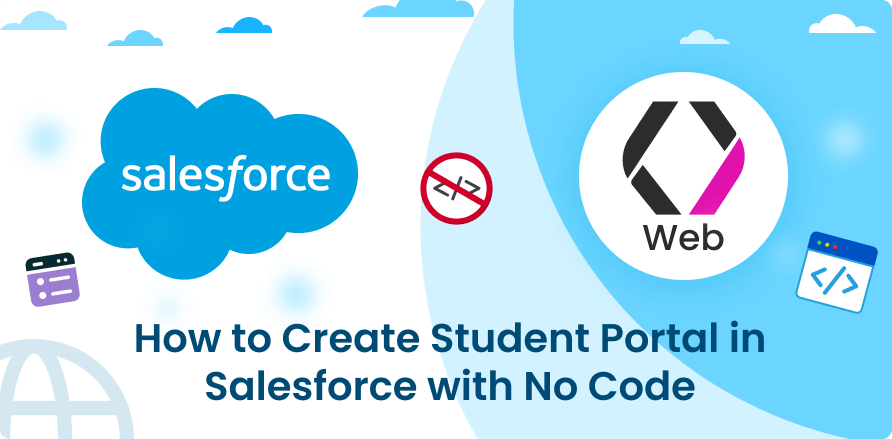
Building a student portal in Salesforce’s Education Cloud can be achieved with two tools that support no-code capabilities and allow for detailed customization: Student Success Hub with Experience Cloud and Titan Web. These tools simplify the process of creating a dynamic, accessible, and student-centered portal.
Education Cloud with Experience Cloud and Student Success Hub
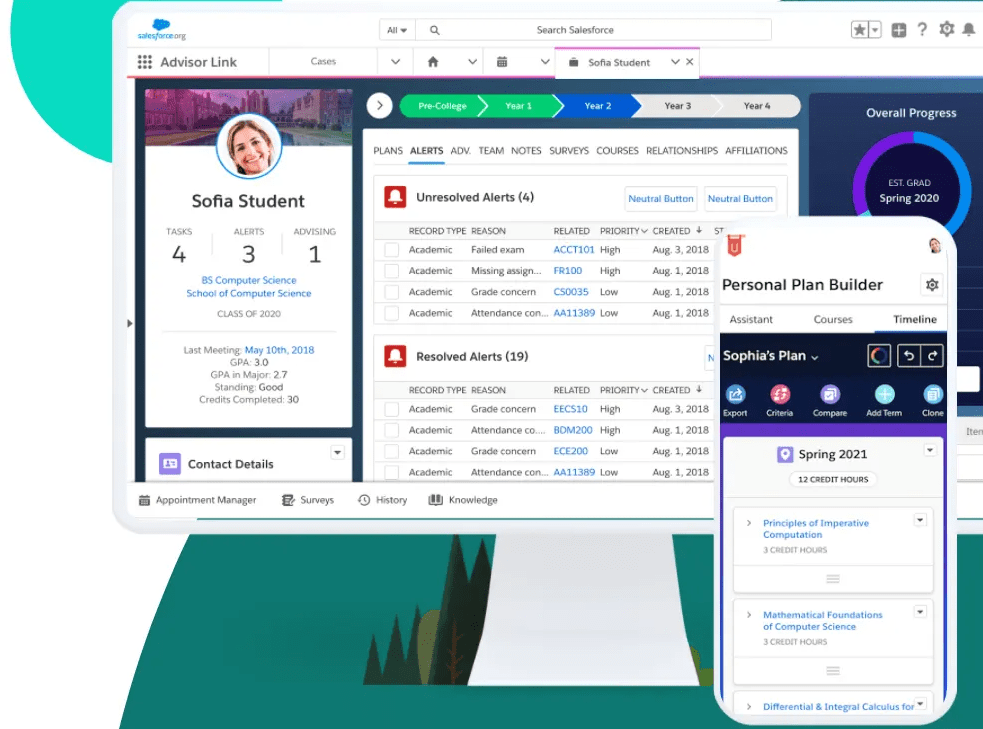
Student Success Hub is a managed package (a bundled set of apps) built on the Education Data Architecture (EDA) framework. It offers the latest tools from Salesforce for Education, enabling your team to fully support each student, track progress, work together on interventions, and measure outcomes effectively. This package helps educational institutions provide well-rounded and fair support by linking students with the services they need to succeed.
Salesforce Experience Cloud
Experience Cloud, a premium Salesforce tool, enables educational institutions to create custom portals and online spaces for students. However, it requires an additional license on top of Education Cloud, which increases costs, and some coding may still be necessary for advanced customizations.
Capabilities:
- Full Salesforce Integration: Experience Cloud connects seamlessly with other Salesforce products, making it ideal for institutions already using Education Cloud.
- Advanced Features: Digital experience management, role-based data sharing, and customer/partner identity management are built-in, enhancing user interaction.
Limitations:
- High Cost: Pricing starts at €15 per login or €35 per member per month, billed annually, making it a substantial investment, especially for institutions with large user bases.
- Requires Some Coding: While it includes low-code builders, complex customizations usually need developer support, adding to overall costs.
Experience Cloud is ideal for schools deeply invested in the Salesforce ecosystem and needing a customized portal with advanced integration options. However, achieving this high level of customization requires coding, so it’s best suited for institutions with both a development budget and the time to implement and maintain these custom features.
Titan Web
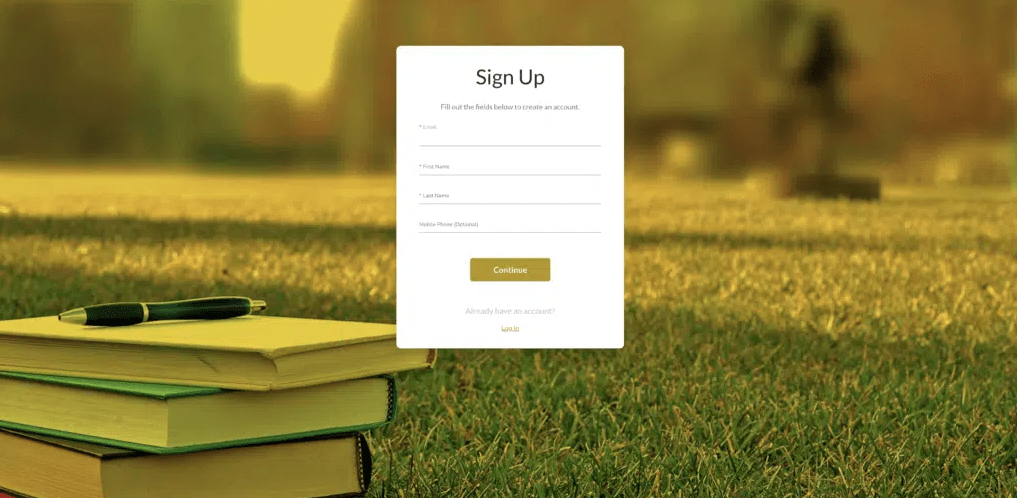
Titan Web works alongside Education Cloud to bring a higher level of customization without the need for coding. With Titan, schools and universities can create interactive forms, secure document uploads, and even handle payments—all with a simple drag-and-drop setup that connects smoothly with Salesforce.
This no-code platform is especially helpful for institutions that need advanced workflows in their student portals. Schools can set up personalized forms, track submissions, and add detailed data fields without needing any programming skills.
One of the key advantages of Titan is its flexibility. Institutions can use it to build a student portal entirely on its own, without needing Experience Cloud or Education Cloud licenses. This makes it a more budget-friendly option for those who want to control costs while still getting all the essential features for student engagement and management.
Capabilities:
- No-Code Customization: Titan allows institutions to create and customize portals, forms, and documents without needing any coding skills.
- Extendable with or without Salesforce Licenses: Titan can be used to enhance existing Salesforce tools like Education Cloud, or function as a standalone portal solution without requiring either license.
Pricing: Titan pricing is based on selected features, typically making it more budget-friendly compared to Education Cloud with Experience Cloud. For instance, individual tools like Titan Docs or Titan Sign can be added as needed, helping schools manage costs while getting only the functionalities they require.
Titan Web’s real-time data updates ensure that any information submitted by students is instantly available within Salesforce, allowing staff to manage records efficiently. This setup is ideal for institutions that want advanced functionalities, such as automated data collection for applications or custom scheduling and registration tools, without the need for extensive development
Choosing Between Education Cloud with Experience Cloud and Titan
- Experience Cloud: Ideal for institutions deeply invested in Salesforce, needing advanced integrations and customizable community spaces. However, it comes with higher costs and potential coding requirements.
- Titan: Perfect for schools looking for a flexible, cost-effective, no-code option. Titan’s versatility means it can serve as a standalone solution or extend Education and Experience Cloud features without additional license costs.
Price and Feature Comparison Summary
| Feature | Experience Cloud | Titan |
| Price | €15/login or €35/member per month | Does not charge per login/user, Titan gives you all that you need in one package. |
| Setup | Coding knowledge is required for customizations | Fully no-code |
| Integration | Seamless with all Salesforce products | Salesforce compatible can also work standalone |
| Storage per Member/Login | 20MB data, 1GB file | Determined by Titan package |
| API Calls/Day | 400/member or 200/login | Based on the chosen integration features |
| Support | Standard, with premium options | Included, with customizable support |
With Titan, institutions can enjoy value for money, and no-code customizations for their student portals, while Experience Cloud offers extensive integration and high-end features—though at a premium price and with a need for developer support.
Together, Education Cloud with Student Success Hub and Titan Web enable institutions to deliver a seamless, user-friendly experience for students, whether they need to schedule an advising session, check their academic progress, or update personal information.
Key Functionalities of a Salesforce Student Portal
A well-designed Salesforce student portal serves as a comprehensive hub where students can independently access essential resources and services. Here’s a breakdown of the key functionalities that no-code portals for Salesforce Higher Education can offer:
Personal Information Management
The portal allows students to update their profiles, including contact details, emergency contacts, and personal preferences. Using Education Cloud with Student Success Hub, institutions can securely store and manage this information, making it easily accessible for both students and administrative staff. Students can make real-time updates that reflect instantly in Salesforce, saving staff from manual data entry.
Course Registration and Grades
Through Education Cloud’s Student Success Hub, students can register for courses, view schedules, and track their academic progress within a single portal. Features like online degree planning allow students to view courses needed for graduation, schedule classes, and monitor grades—all without visiting campus offices. Titan Web can further enhance this functionality by adding custom fields and workflows to handle registration requirements, prerequisites, and deadlines.
Document Uploads and Forms
With Titan Web, students can upload necessary documents, such as admission forms, transcripts, or financial aid applications, directly through the portal. Titan supports secure file uploads, ensuring documents are securely transmitted and stored within Salesforce. This functionality not only makes document submission easier for students but also keeps administrators organized and up-to-date without relying on physical paperwork.
Communication Tools
Salesforce portals allow students to connect with advisors, professors, and support staff, often through integrated messaging and appointment scheduling. Student Success Hub supports real-time communication by enabling students to book appointments with academic advisors, join virtual meetings, or receive alerts if they need additional support. Additionally, queue management within Student Success Hub lets staff handle walk-in appointments, making it easy to support students both in person and remotely.
Each of these features contributes to a seamless, student-centered experience, empowering students to manage their academic needs independently while streamlining processes for faculty and administrative staff.
Steps to Build a No-Code Student Portal in Salesforce
With Education Cloud and Titan Web, institutions can create a fully functional student portal that allows students to manage applications, submit documents, and more. Here’s a step-by-step guide to setting up a student application portal in Salesforce:
Set Up Student Signup Form
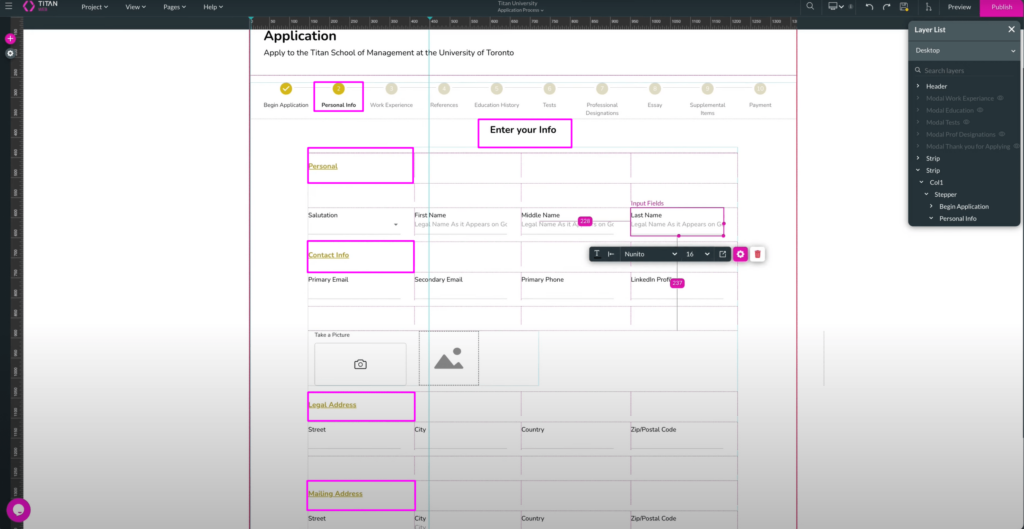
Create a simple signup form for students to enter basic details, such as their name and email. When submitted, this information is saved directly in Salesforce as a Contact record, providing an immediate link between student submissions and Salesforce data.
Enable Portal Login with 2FA
Configure the portal to allow students to log in using their email addresses. Enhance security by integrating two-factor authentication (2FA), which sends a verification code to the student’s email. Once they enter the correct code, students gain access to their personalized portal, secured with Salesforce’s robust authentication protocols.
Create Application Dashboard
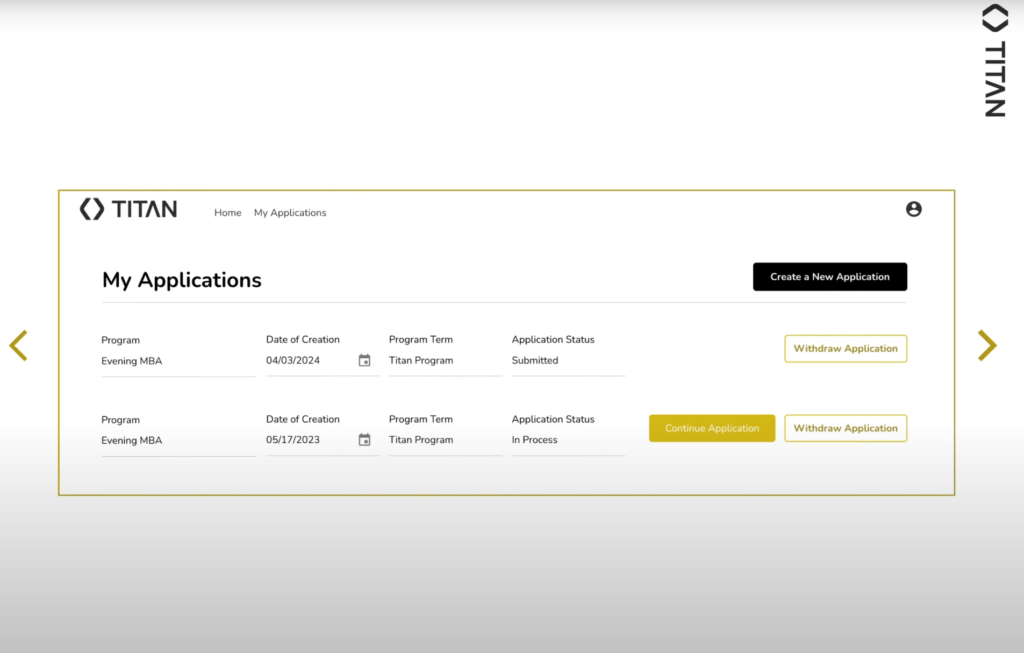
Set up a dashboard that displays all application statuses (e.g., submitted, in-progress, rejected). Students can also start new applications by selecting their preferred program and term from a Salesforce-powered dynamic picklist, keeping program choices accurate and up-to-date.
Personal Information Retrieval from Salesforce
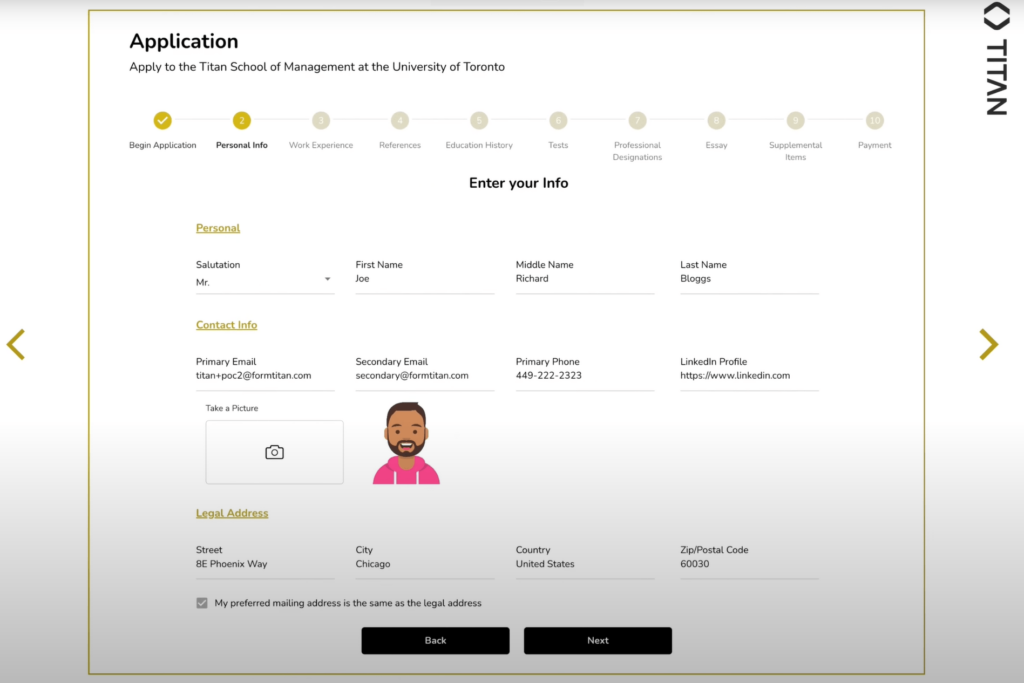
Automatically pull students’ existing information from Salesforce, such as contact details and addresses, for easy reference and updates within the portal. This integration minimizes data redundancy and ensures that records remain synchronized across systems.
Add Work Experiences
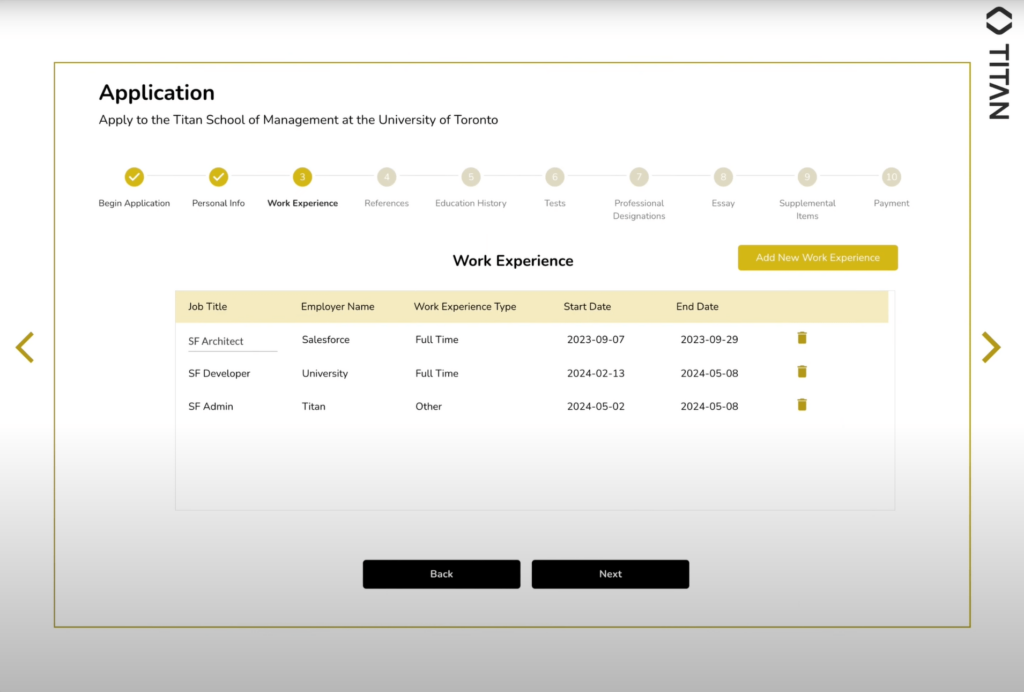
Allow students to input multiple work experiences, stored in Salesforce as Affiliation records under the “Work History” type. Any updates students make, such as adding or removing experiences, appear instantly in Salesforce.
Add References
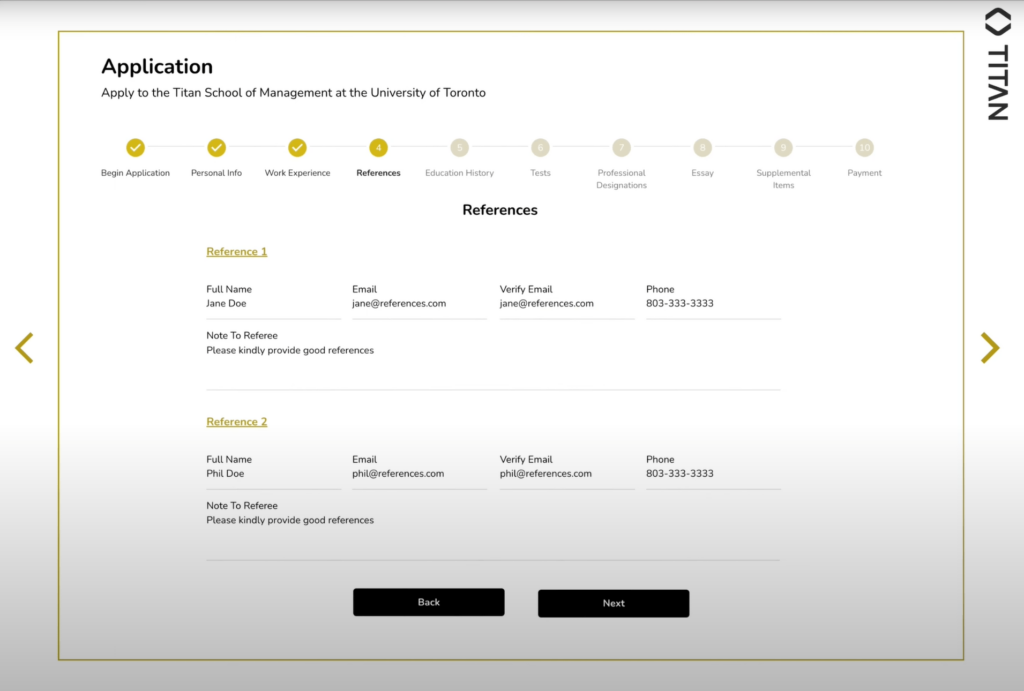
Students can add up to two references as part of their application, with each reference saved directly in Salesforce. These references link to the main application record, offering a clear overview of all references in one section for easy reference during application reviews.
Education History
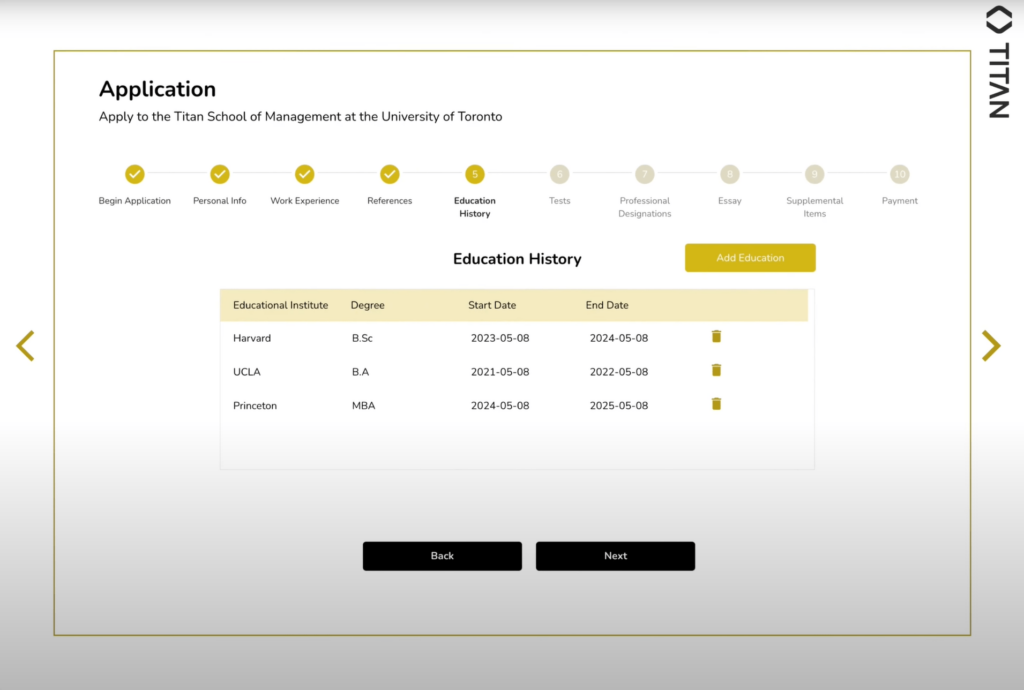
Provide fields for students to list their previous education history, which is recorded in Salesforce as Affiliation records under “Education History.” Real-time sync ensures that as students enter each new entry, their records in Salesforce automatically update.
Professional Designations
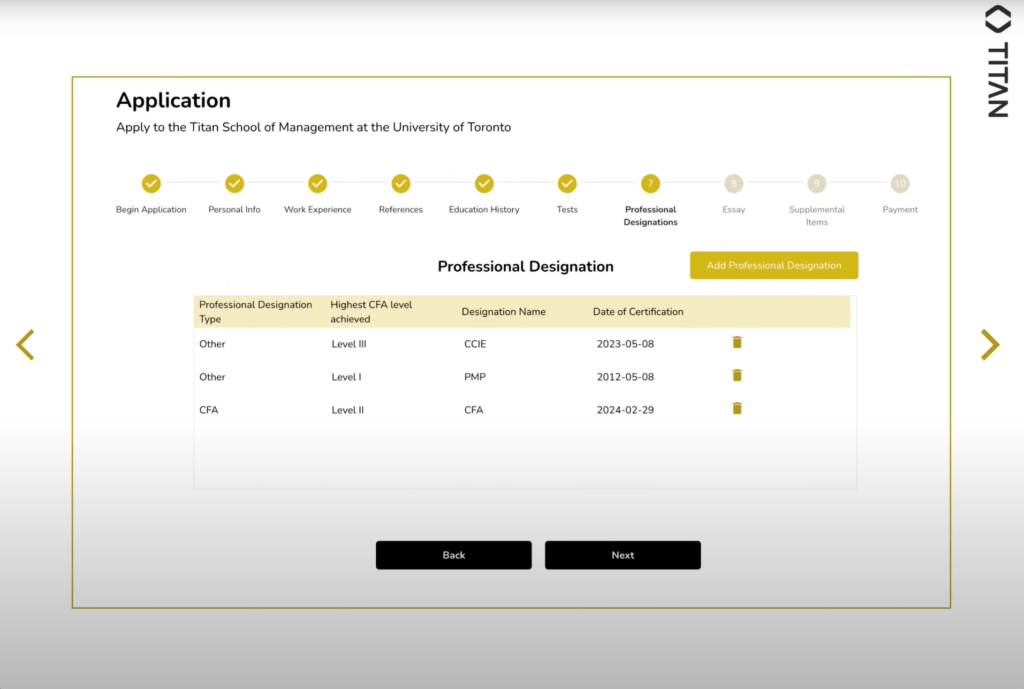
Add fields for students to list certifications or designations, which are saved as individual records in Salesforce. Each entry syncs instantly, giving the admissions team immediate access to students’ professional qualifications.
Essay Submission with Version Control
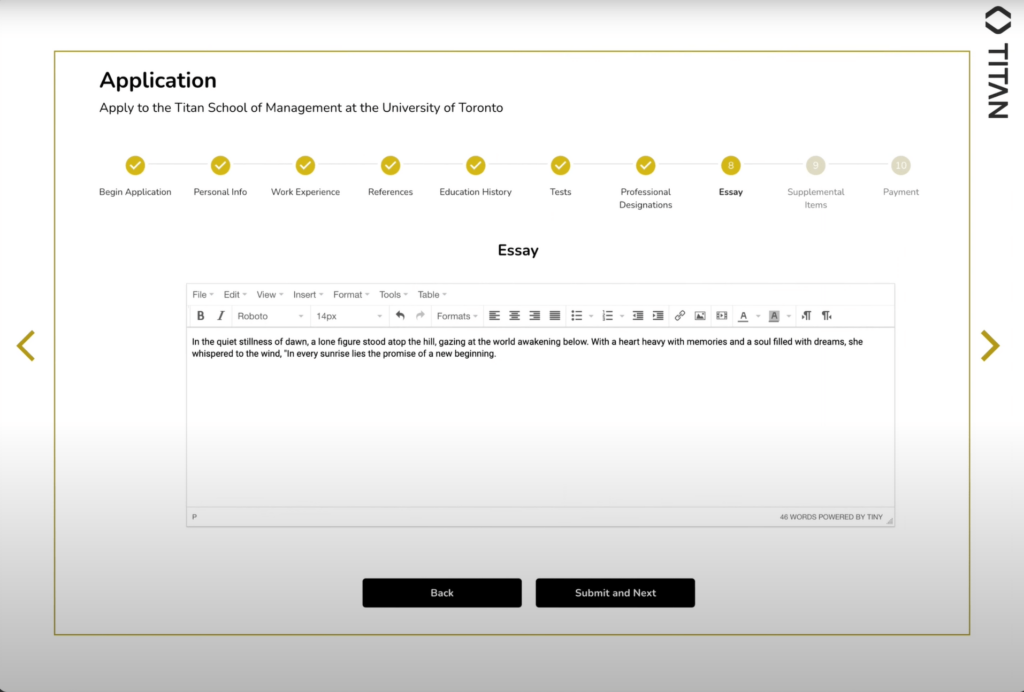
Set up a rich text field for essays or personal statements. If students submit a new version, Salesforce maintains a record of previous versions for comparison. This feature helps admissions staff keep track of changes without losing earlier submissions.
Upload Supplemental Documents
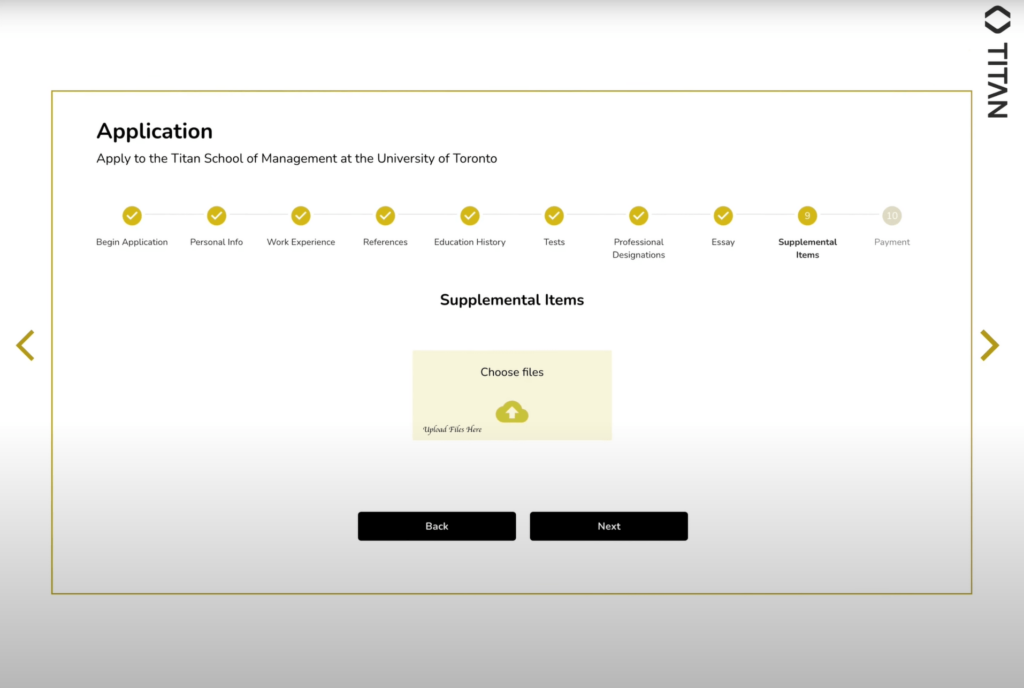
Enable a file upload feature for supporting documents (e.g., transcripts, recommendation letters). Uploaded files appear in the Salesforce application record, with options for previewing or deleting files.
Payment Integration with Stripe
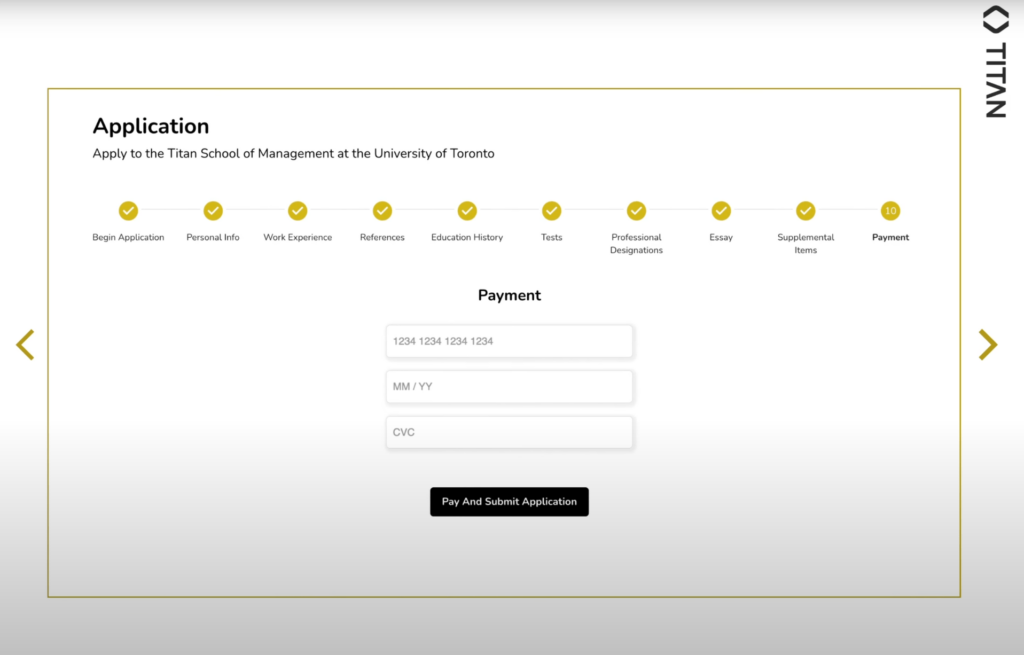
Integrate Stripe for secure payment processing. Upon successful payment, the application status updates to “Submitted” in Salesforce, with payment details stored for record-keeping.
Final Review in Salesforce
Ensure all records—work history, education, references, essays, documents, and payment—are synced correctly within Salesforce. Conduct a final refresh in Salesforce to verify that each record reflects a fully submitted application.
Following these steps with Education Cloud and Titan Web provides a seamless setup for managing student applications in Salesforce, from signup to final submission, complete with secure, real-time data sync across records.
Best Practices for Creating a Student Portal in Salesforce
Implementing a student portal requires more than just functional components; it also involves a focus on usability, security, and accessibility. Here are some best practices to consider when building a student portal in Salesforce:
Ensure User-Friendly Navigation
Why it Matters: A straightforward, intuitive design allows students to find what they need quickly, reducing frustration and enhancing engagement.
Tip: Group similar functions together (e.g., applications, registrations, support) and add a search bar for easy access. A clear menu structure can simplify the portal experience, especially for mobile users.
Prioritize Data Security and Privacy
Why it Matters: Student data includes sensitive information, so it’s critical to enforce strong security protocols.
Tip: Use Salesforce’s built-in sharing settings and role-based permissions to control who can view, edit, or delete records. Enable two-factor authentication (2FA) for an extra layer of security during login, which prevents unauthorized access to student accounts.
Optimize for Mobile Use
Why it Matters: Students often access portals on the go, so mobile compatibility ensures they have a seamless experience on any device.
Tip: Test the portal layout on both desktop and mobile. Consider using mobile-responsive templates in Education Cloud and test Titan Web forms on various devices to confirm that all features load correctly and remain user-friendly.
Utilize Real-Time Data Syncing
Why it Matters: Real-time updates help maintain accurate records and allow students and staff to interact with the latest information.
Tip: With Titan Web, set up real-time data syncing with Salesforce so that any updates made by students—such as profile changes, document uploads, or payments—are immediately visible to staff. This minimizes errors and reduces administrative follow-up.
Streamline Communication Channels
Why it Matters: Clear and efficient communication keeps students informed and engaged, reducing the number of support inquiries.
Tip: Integrate communication tools within the portal, such as chat options, direct messages, or appointment scheduling. Student Success Hub’s alerts and notifications can help staff proactively communicate important updates and ensure students are aware of deadlines or tasks.
Provide Access to Support Resources
Why it Matters: Having help resources directly in the portal enables students to resolve issues independently, reducing the need for staff intervention.
Tip: Include a FAQ section, tutorial videos, and access to support articles. For more complex issues, add an option to book time with advisors directly through the portal, allowing students to seek guidance as needed.
Regularly Update and Maintain the Portal
Why it Matters: Keeping the portal up to date with new features and improvements ensures it remains relevant and useful for students.
Tip: Regularly check for Salesforce updates to ensure that new features in Education Cloud or Student Success Hub are applied to the portal. Periodic feedback from students can also guide necessary improvements to make the portal more user-centric.
Applying these best practices can enhance the functionality and accessibility of a student portal in Salesforce, creating a more supportive and responsive environment for students.
FAQs about Student Portal Setup in Salesforce
Below are some frequently asked questions about setting up and managing a student portal in Salesforce, focusing on Education Cloud and no-code options like Titan Web:
How can a no-code student portal in Salesforce improve the application process?
A no-code portal streamlines the application process by allowing students to submit applications, track statuses, and upload necessary documents all within a single platform. The real-time syncing capabilities of tools like Titan Web and Student Success Hub mean that administrators have instant access to new submissions, allowing faster processing and fewer manual data entry tasks.
What features can I include in a Salesforce student portal without code?
Using Education Cloud and Titan Web, institutions can include a variety of features like appointment scheduling, task tracking, document uploads, and secure login with two-factor authentication. These tools allow portal customization with no coding required, enabling institutions to set up functionalities specific to their needs.
How does payment integration work in a no-code Salesforce portal?
Titan Web can be integrated with payment providers like Stripe to process applications or course fees directly through the portal. Once payment is made, the application status updates automatically in Salesforce, ensuring a seamless process for both students and administrative staff
Can students update their information through the portal?
Yes, students can update personal information like contact details, education history, and work experience. These updates sync instantly to Salesforce, allowing staff to access the latest information without the need for additional data entry.
How secure is a no-code student portal?
Salesforce’s Education Cloud and Student Success Hub offer built-in security features, including user authentication, role-based permissions, and data encryption. By implementing two-factor authentication (2FA) and controlling access through role settings, institutions can ensure data security while providing students with secure, user-friendly access to the portal.
Wrapping Up
Building a Salesforce student portal using Education Cloud and Titan Web creates an all-in-one platform that connects students directly to essential academic resources and support systems. With Salesforce for students, the portal becomes a robust student information system, where data updates in real-time, and students have easy access to tasks like course registration, document uploads, and appointment scheduling.
Education Cloud serves as the backbone of the student portal, bringing together all student data in one secure, accessible place. This setup ensures that students can quickly check grades, track application statuses, and connect with advisors, all within a familiar, easy-to-navigate portal environment.
Titan Web enhances the portal’s functionality by offering no-code options for personalized forms, secure document uploads, and payment processing. The real-time syncing of Titan Web with Salesforce means students can interact with up-to-date information, creating a seamless and reliable experience.
For institutions, creating a student portal website through the Salesforce student information system and Education Cloud makes managing student needs simpler and more efficient, empowering students to take charge of their own academic journey. With the flexibility to adapt to any institution’s requirements, this portal provides a unified, accessible, and student-focused solution that supports long-term success.

Dorian is a 6X Certified Salesforce Developer and Administrator with a start in the IT world as a CRM Admin in 2020. Since diving into Salesforce in 2021 via Trailhead and Focus on Force, he has achieved a Ranger Rank, earned several Superbadges, and bagged certifications including the Salesforce Certified Administrator, Platform App Builder, Associate and Platform Developer I by 2023. In 2024 he also became Salesforce Certified AI Associate and earned Certified AI Specialist Certification in 2025. Dorian is very keen on continuous learning, always looks for fresh ways to improve his knowledge. He enjoys running, boxing, kickboxing and reading diverse kinds of books in his free time.


 Previous Post
Previous Post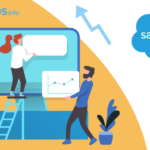 Next Post
Next Post